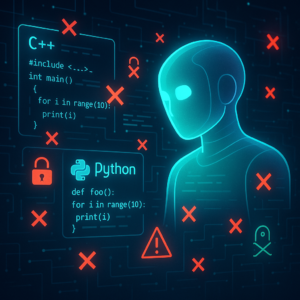Can You Tell If This Code Was Written By a Machine?

Can You Tell If This Code Was Written By a Machine?
In today’s digital age, where artificial intelligence (AI) boasts some impressive tricks, one question keeps cropping up: “Can you tell if this piece of code was written by a human or an AI?” This curiosity isn’t just because AI, like OpenAI’s ChatGPT, can produce human-like text and code, it’s also about addressing the ethical and quality concerns in industries where the distinction between machine and human work is crucial.
Enter CodeGPTSensor, a groundbreaking tool developed by a team of researchers aiming to sniff out machine-generated code using innovative methods like contrastive learning. Let’s dive into how this nifty tool works and why it’s a game-changer!
The Magic Behind CodeGPTSensor
What’s the Buzz About LLMs?
Before we immerse ourselves in CodeGPTSensor, it’s essential to understand the ecosystem it’s operating in. Large Language Models (LLMs), such as ChatGPT, have taken the tech world by storm with their ability to produce text and even code with surprising accuracy. Yet, while these models are great at speeding up workflows, they also pose risks—think of misinformation in news or code vulnerabilities in software engineering.
The Need for CodeGPTSensor
While we have tools to detect AI-generated prose, distinguishing code generated by AI has traditionally been tricky. This is where CodeGPTSensor comes in. Leveraging a technique called contrastive learning, the model can differentiate between human-written code and code cooked up by AI by identifying subtle differences in their structures and styles.
How Does It Work?
Here’s the lowdown on how CodeGPTSensor operates:
-
Data Collection: The researchers put together a massive collection—550,000 pairs, to be precise—of human versus AI-generated code from languages like Python and Java.
-
The Learning Process: The core magic happens in the model training phase where CodeGPTSensor uses UniXcoder, a semantic wizardry tool that dives deep into the code’s syntax and structure.
-
Contrastive Learning: Imagine teaching the model using a “spot the difference” approach—where it’s trained to recognize the minute dissimilarities between two pieces of code, one from a human, another from an AI. This is contrastive learning in action, and it significantly boosts the model’s coding discernment skills.
What Did the Research Uncover?
Challenges in Spotting AI Code
Spotting the difference isn’t easy. In tests where developers tried to manually identify which code was AI-generated and which wasn’t, they often found themselves guessing wrong. Their accuracy was akin to flipping a coin for answers, which underscores why sophisticated tools like CodeGPTSensor can shine in such tasks.
Characteristics of AI-generated Code
Researchers identified tell-tale signs in AI-crafted code. For example, AI often sticks to certain coding styles and standard libraries more strictly compared to the variety seen in human code. In contrast, humans might showcase more creativity—or unpredictability—in how they solve problems.
Real-World Implications
Having a tool like CodeGPTSensor at one’s disposal isn’t just a cool tech flex. It’s a practical necessity for ensuring code integrity, especially in scenarios where it impacts security or ethics. Here’s how it might play out:
- In Education: Institutions can ensure homework handed in by students is their own effort.
- In Software Development: Teams can maintain code standards by highlighting AI-generated segments that may need a closer look for errors or vulnerabilities.
- In Commercial Settings: Verifying code origins could reassure clients doubting the originality and safety of the software delivered to them.
Key Takeaways
-
LLMs Like ChatGPT Are Here to Stay: While awesome for productivity, they bring challenges in code integrity and ethics.
-
CodeGPTSensor Offers a Cutting-edge Solution: By using contrastive learning, it can effectively differentiate between human and AI-generated code.
-
Applications Are Broad and Diverse: From boosting educational ethics to safeguarding commercial software projects, the impact is wide-reaching.
-
The Skill You’re Learning Here? Improvisation: AI is great, but knowing when it’s taken the wheel helps ensure everything stays on track.
Technology like CodeGPTSensor exemplifies our continuous dance with AI—leveraging its tremendous capabilities while ensuring we have safeguards to maintain quality and security. As AI continues to evolve, so too must our tools and techniques to keep it in harmony with human needs.
If you are looking to improve your prompting skills and haven’t already, check out our free Advanced Prompt Engineering course.
This blog post is based on the research article “Distinguishing LLM-generated from Human-written Code by Contrastive Learning” by Authors: Xiaodan Xu, Chao Ni, Xinrong Guo, Shaoxuan Liu, Xiaoya Wang, Kui Liu, Xiaohu Yang. You can find the original article here.




